Hard Disk Drives with HAMR Technology Set to Arrive in 2018
by Anton Shilov on December 24, 2015 9:00 AM EST- Posted in
- HDDs
- Seagate
- Toshiba
- Western Digital
- HGST
- HAMR
- Showa Denko
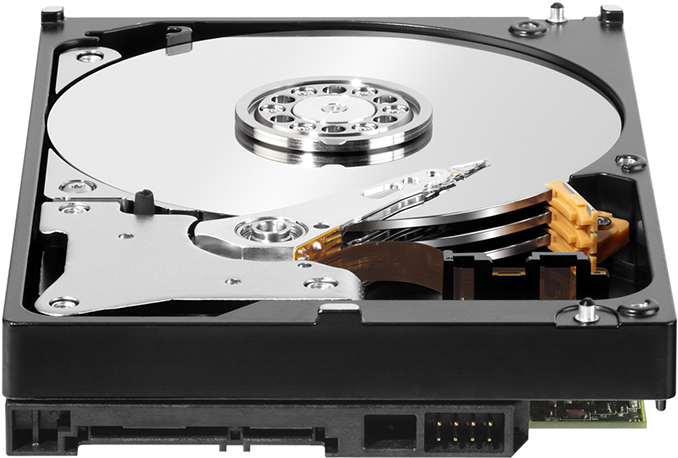
While many client devices use solid-state storage technologies nowadays, hard disk drives (HDDs) are still used by hundreds of millions of people and across virtually all datacenters worldwide. Heat-assisted magnetic recording (HAMR) technology promises to increase capacities of HDDs significantly in the coming years. Unfortunately, mass production of actual hard drives featuring HAMR has been delayed for a number of times already and now it turns out that the first HAMR-based HDDs are due in 2018.
Storage Demands Are Increasing
Analysts from International Data Corp. and Western Digital Corp. estimate that data storage capacity shipped by the industry in 2020 will total approximately 2900 exabytes (1EB = 1 million TB), up from around 1000EB in 2015. Demand for storage will be driven by various factors, including Big Data, Internet-of-Things, user-generated content, enterprise storage, personal storage and so on. Samsung Electronics believes that the NAND flash industry will produce 253EB of flash memory in 2020, up from 84EB in 2015. Various types of solid-state storage will account for less than 10% of the storage market in terms of bytes shipped, whereas hard drives, tape and some other technologies will account for over 90%, if the estimates by IDC, Samsung and Western Digital are correct.
In a bid to meet demand for increased storage needs in the coming years, the industry will need to expand production of NAND flash memory as well as to increase capacities of hard disk drives. Modern HDDs based on perpendicular magnetic recording (PMR) and shingled magnetic recording (SMR) platters have areal density of around ~0.95 Terabit per square inch (Tb/in²) and can store up to 10TB of data (on seven 1.43TB platters). Technologies like two-dimensional magnetic recording (TDMR) can potentially increase areal density of HDD disks by 5 to 10 per cent, which is significant. Moreover, Showa Denko K.K. (SDK), the world’s largest independent maker of hard drive platters, has outlined plans to mass produce ninth-generation PMR HDD media with areal density of up to 1.3Tb/in² next year.
HAMR: The Key to Next-Gen HDDs
Companies like Seagate Technology and Western Digital believe that to hit areal densities beyond 1.5Tb/in², HAMR technology along with higher anisotropy media will be required because of supermagnetic limit (physical “pitches” on optical media become so tiny that it will not be possible to produce a powerful enough magnetic field in the HDD space to write data into them).
Certain principles of heat-assisted magnetic recording were patented back in 1954, even before IBM demonstrated the very first commercial hard disk drive. Heat-assisted magnetic recording technology briefly heats magnetic recording media with a special laser close to Curie point (the temperature at which ferromagnetic materials lose their permanent magnetic properties) to reduce its coercivity while writing data on it. HAMR HDDs will feature a new architecture, require new media, completely redesigned read/write heads with a laser as well as a special near-field optical transducer (NFT) and a number of other components not used or mass produced today.
According to Seagate, its HAMR heads heat media to approximately 450°C using a laser with 810nm wavelength and 20mW power. The company does not disclose any details about its HAMR recording heads because they are the most crucial part of the next-generation hard drives. HDD makers, independent producers of recording heads, universities and various other parties have researched HAMR heads for years. NFT is a very important components of any HAMR head. It has to deliver the right amount of energy into a spot diameter of 30nm or smaller. NFT also has to be durable and reliable, which is something that many researchers are working on.
This month Showa Denko disclosed its roadmap for next-generation hard drive media. While such plans tend to change as products get closer to mass production, at present SDK expects its first 2.5” platters for HAMR drives to feature 1.2TB – 1.5TB capacity (areal density of 1.5Tb/in² – 1.95Tb/in²). By the end of the decade, capacity of 2.5” disks for HDDs is projected to increase to 2TB. Showa Denko’s forecasts clearly show the benefits of HAMR technology and its potential.
In Development for Years
Manufacturers of hard disk drives, heads and HDD media have been working on technologies to enable HAMR-based HDDs for well over ten years now, as soon as they realized that at some point HAMR technology would be required to build hard drives with higher capacities.
Starting from mid-2000s, various manufacturers of HDDs have demonstrated prototype HDDs that used HAMR technology for a number of times. For example, Western Digital showcased a 2.5” hard drive that used HAMR tech back in late 2013. In mid-2015, Seagate displayed a NAS powered by multiple drives featuring heat-assisted magnetic recording.
Numerous demonstrations of HAMR-based HDDs in action prove that the technology actually works. Over the years, producers of hard drives, platters and recording heads have revealed various possible timeframes for commercial availability of drives with HAMR technology. Their predictions were not accurate. At present, there are still reliability issues with the technology, according to Seagate. In the recent months both Seagate and Showa Denko indicated that HAMR drives would be delayed again.
Still Not Ready for Commercial Products
Seagate plans to ship prototypes of its HAMR-based drives to select customers in late 2016 or early 2017. The drives will be intended mostly for test purposes. They will help Seagate and the company's clients to understand how reliable the HAMR-powered HDDs are in actual datacenters, whether they are compatible with existing infrastructure and how fast they are in real-world applications. Evaluation will take a long time and chances that Seagate starts volume shipments of hard disk drives with HAMR technology in 2017 are low.
Last week Showa Denko also said that its platters for hard disk drives that use heat-assisted magnetic recording technology would be delayed to 2018.
“As for new generation technologies, HAMR or TAMR, the start of mass production will be [slightly] delayed to 2018,” said Hideo Ichikawa, president of Showa Denko. The official mid-term business plan of the company reads that the new-generation media "will be launched in or after 2018".
While it is evident that HAMR-powered hard drives are not ready for prime time, producers of HDDs do not reveal the nature of the issues. Seagate indicated earlier this year that HAMR-based drives were not stable enough, but did not elaborate.
Higher-Capacity HDDs Are Incoming
Even though HAMR seems to be at least two years away, hard drive makers will continue to increase capacities of their flagship drives going forward.
SDK promises to start volume production of its ninth-generation perpendicular magnetic recording platters next year. So far, the company has announced that the ninth-gen PMR disks for 2.5” HDDs will feature 1TB capacity. Eventually the tech could be applied to 3.5” platters to increase their capacity up to around 2TB.
Earlier this year Seagate introduced its 2TB hard disk drive in 2.5” form-factor that is just 7mm thick. The drive is based on two 1TB platters, which feature leading-edge 1.3Tb/in² areal density. The same technology will inevitably be used for 3.5” HDDs, enabling Seagate to introduce enterprise-class hard drives with over 10TB capacity in the coming years.
Western Digital Corp. builds high-capacity platters in-house. While exact plans of the company are unclear, its HGST division has consistently offered the world’s highest-capacity hard drives for several years in a row now.
Overall, while HAMR faces another delay, leading producers of hard disk drives will be able to expand capacities of their HDDs using PMR and SMR platters in the coming years.


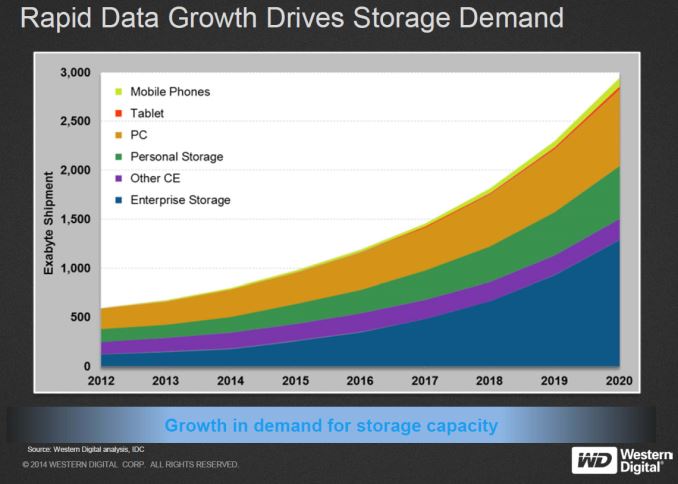
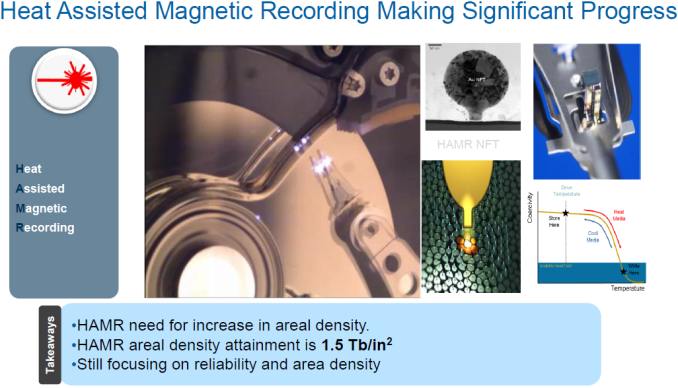
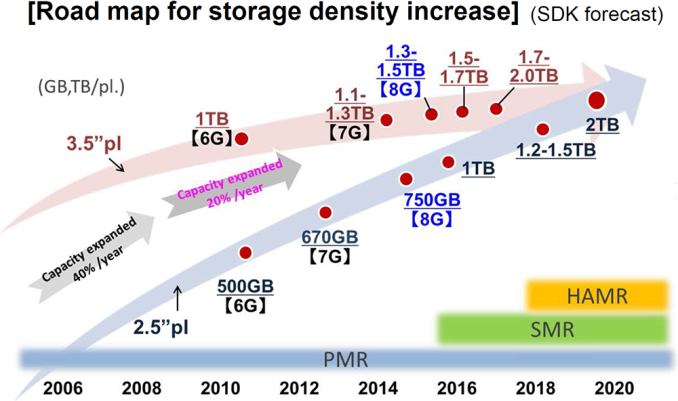
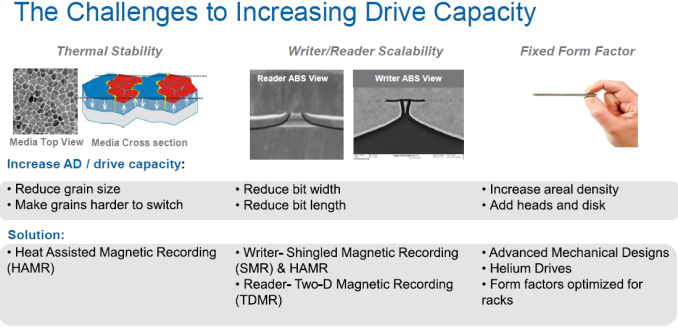
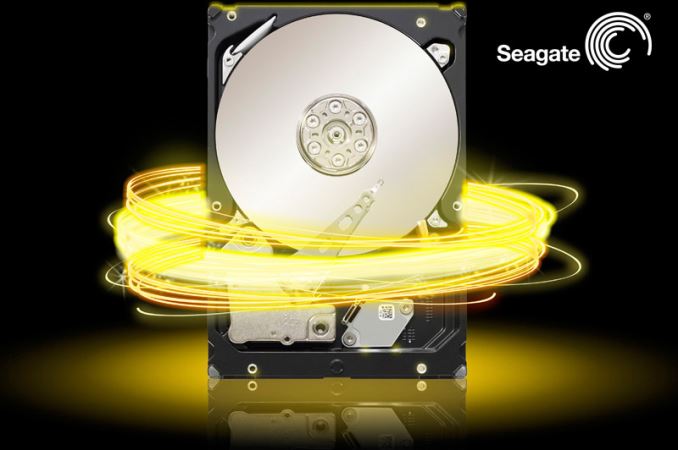
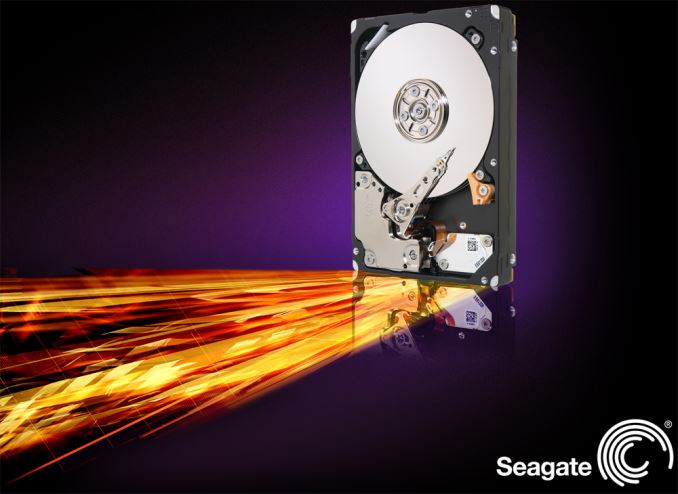








72 Comments
View All Comments
FunBunny2 - Friday, December 25, 2015 - link
NAND and [D|S]RAM are made on the same machines. sort of.CaedenV - Saturday, December 26, 2015 - link
Saying that they are directly tied to RAM prices is not exactly right... but the technologies are both very similar from a manufacturing standpoint, and an ability to improve yields or lower cost in one will typically bleed over to the other.Compare that to HDD manufacturing which is essentially the art of making rust dust store information... improvements there are almost entirely inapplicable to any other technological field.
FunBunny2 - Saturday, December 26, 2015 - link
-- the art of making rust dust store informationwhile I, too, like to call HDD spinning rust, the fact is other metals have been the standard for more than a decade. here: http://www.pcguide.com/ref/hdd/op/media_Media.htm
close - Saturday, December 26, 2015 - link
All the technology needed to create a 256TB SSD out there, just really far away on the same shelf as the one needed to build a 256TB HDD. Just as you wait for denser chips for SSDs you wait for denser platters for HDDs. Just as you add more chips and PCBs in the same SSD case you add more platters and heads in the same HDD case.And there's one commenter here who even "invented" the 5.25" HDD that's a gazillion times faster that an SSD while storing a lot more. That's because we're talking about the "technology" that's out there.
Also, have you read anything about the 6TB SSD from Samsung lately? It's not really on the market and even the price is speculation at this point. Most likely it's 50 times more expensive per GB than a normal HDD. The tech may be somewhere on a shelf but the truth is even in 3 years prices per GB for SSDs will still be 6-8 times higher then for HDDs by every analysis, even ones discussed around here.
bebby - Monday, December 28, 2015 - link
The question is not about the price gap but about market demand: Even if a 6TB HDD is still cheaper, the consumer demand for more than 1TB HDD/SSD is very small in a time where everything is in the cloud. Demand for large HDD remains to be in the server space which is much less profitable than consumer. There is good reason that Samsung sold their HDD biz, because they understand this fully. BTW, SSD and DRAM price cycles are not the same as the price cycle is more about supply discipline and level of competition. There are only very few real competitors in SSD whereas DRAM is fully commoditized. SSDs could be much cheaper if the suppliers would be less disciplined.ddriver - Thursday, December 24, 2015 - link
Making magnetic platters will always be cheaper than making flash memory chips. There is a whole universe of possibilities for improvement in HDDs, however the market is deliberately not taking that route, instead keep on milking the same old runt cow.close - Saturday, December 26, 2015 - link
Also, if they'd just use 4" wide magnetic tape we would have storage devices capable of holding more than 1000 times what a normal HDD can store today with at least 10 times the resiliency and speed. I have all the calculations done. But the bastards in the industry...Back to you ddriver.
stephenbrooks - Thursday, December 24, 2015 - link
Yes, HDDs aren't exactly "clinging" to a price advantage when that price advantage is a factor of 10. The NAND makers would have to do something pretty drastic to close that gap, even by the 2020s.Samus - Thursday, December 24, 2015 - link
That's the problem. NAND technology has had substantially more breakthroughs in a shorter period of time that magnetic technologies. The irony is magnetic technology now needs to be augmented with optical technology to continue increasing aerial density.Long story short, as the OP said, by 2018, 4TB+ NAND drives will be mainstream and the HDD industry will still be using SMR as a crutch to increase storage capacity at the expense of reliability and performance. The only saving grace will be Hitachi's helium drives, which will likely reach 16TB by then.
Lonyo - Friday, December 25, 2015 - link
16TB SSDs are not "available", they have been demonstrated, with an expected release date of next year and a price tag expected to be over $5k. That's 2016 and over 10x the price/GB of mechanical drives.